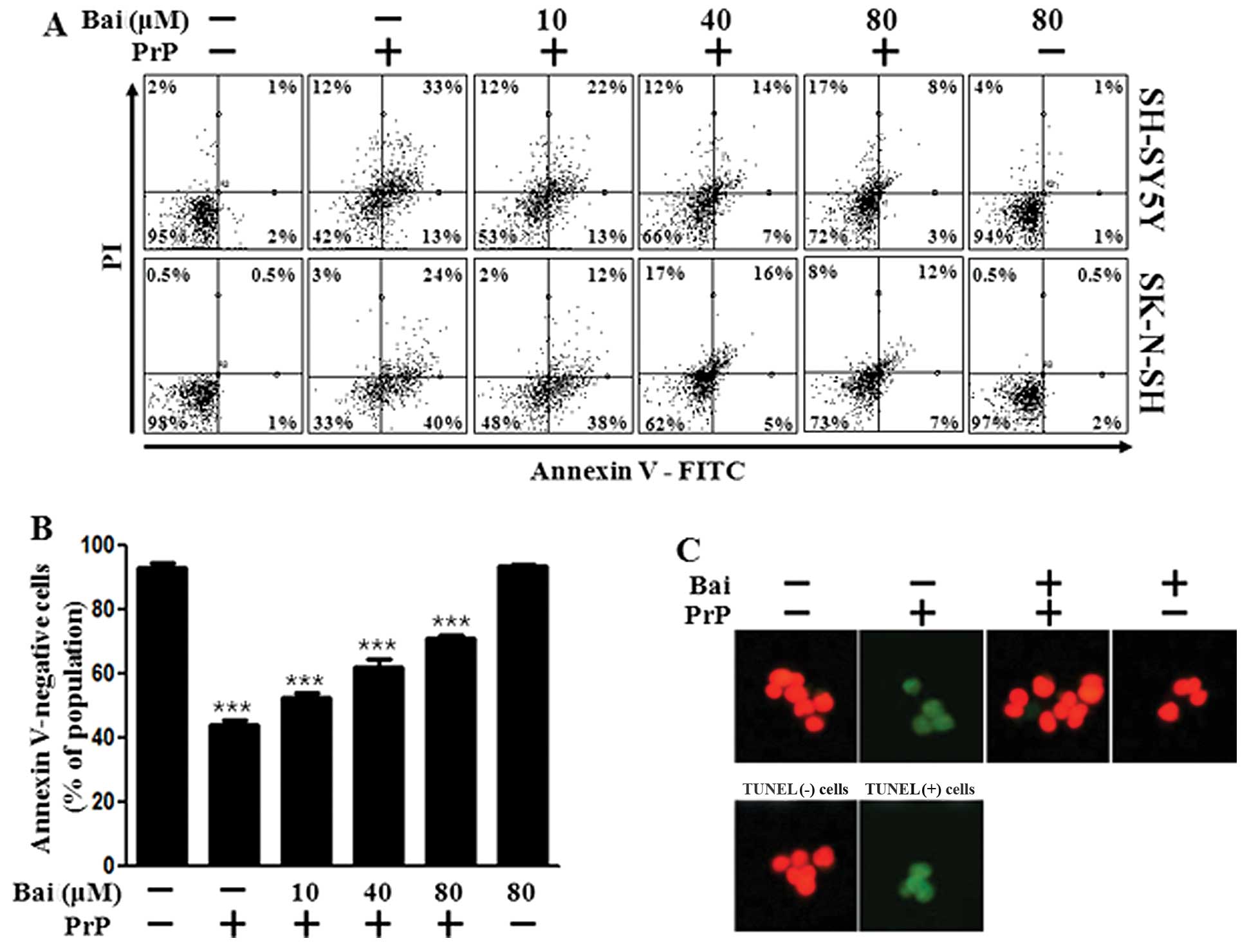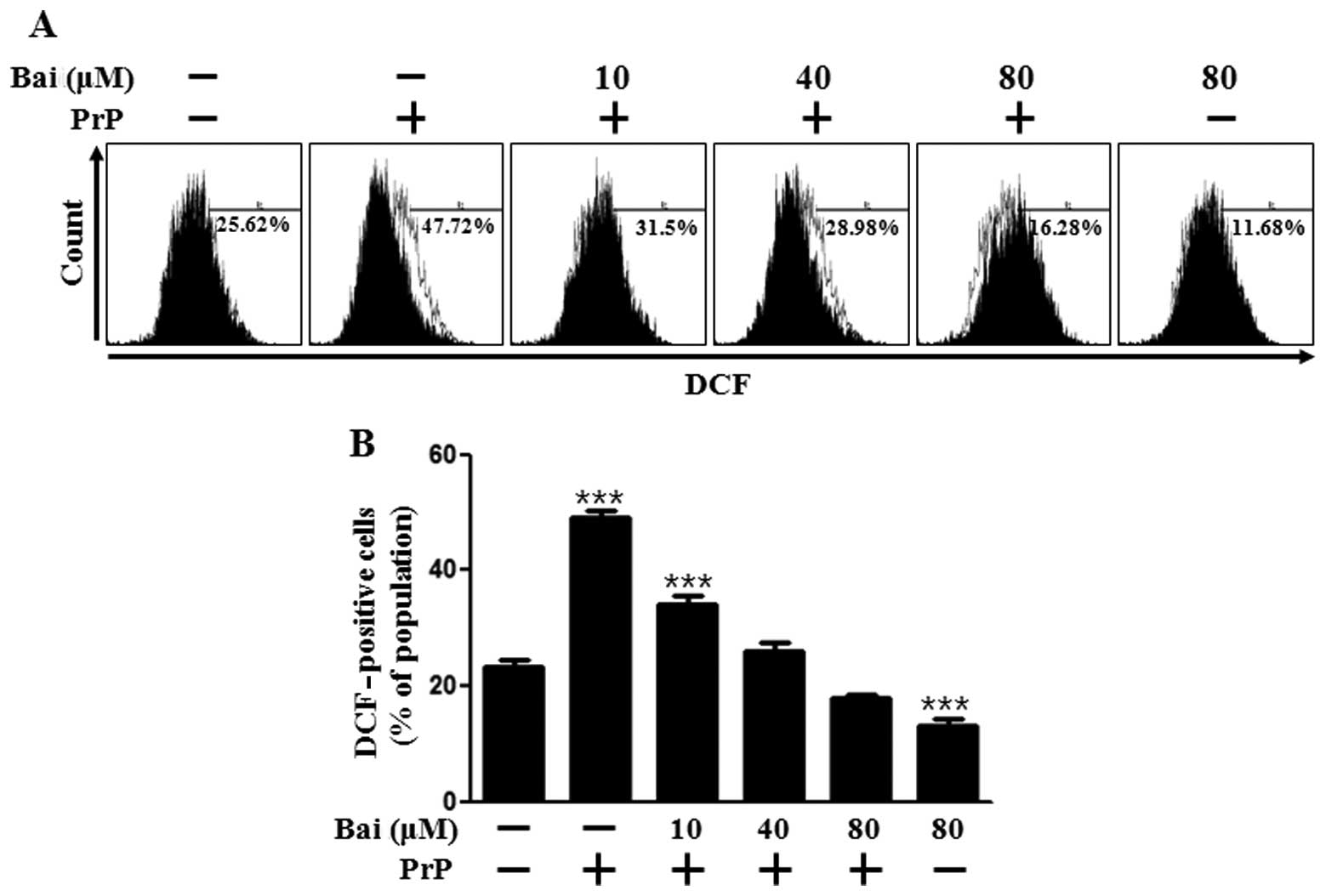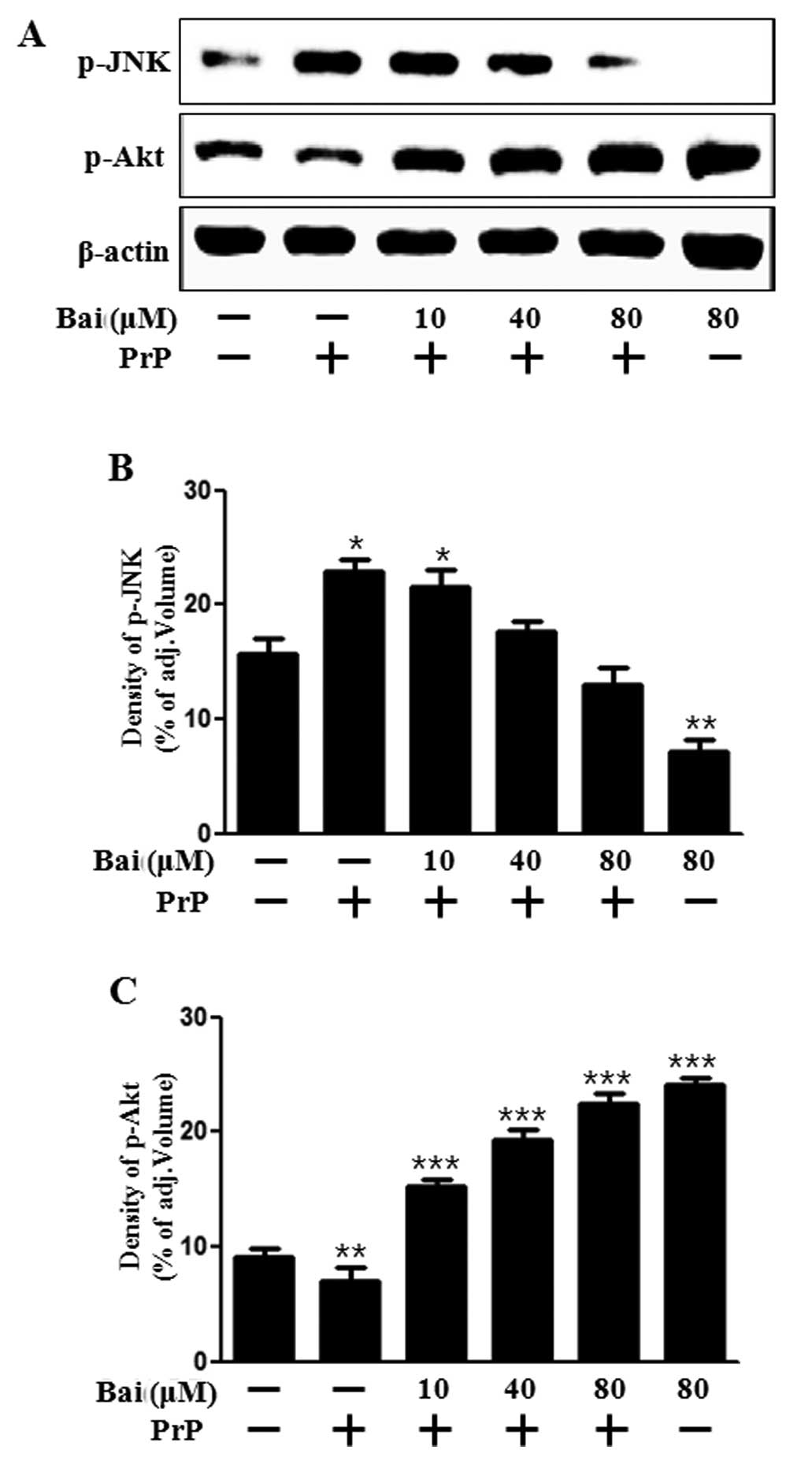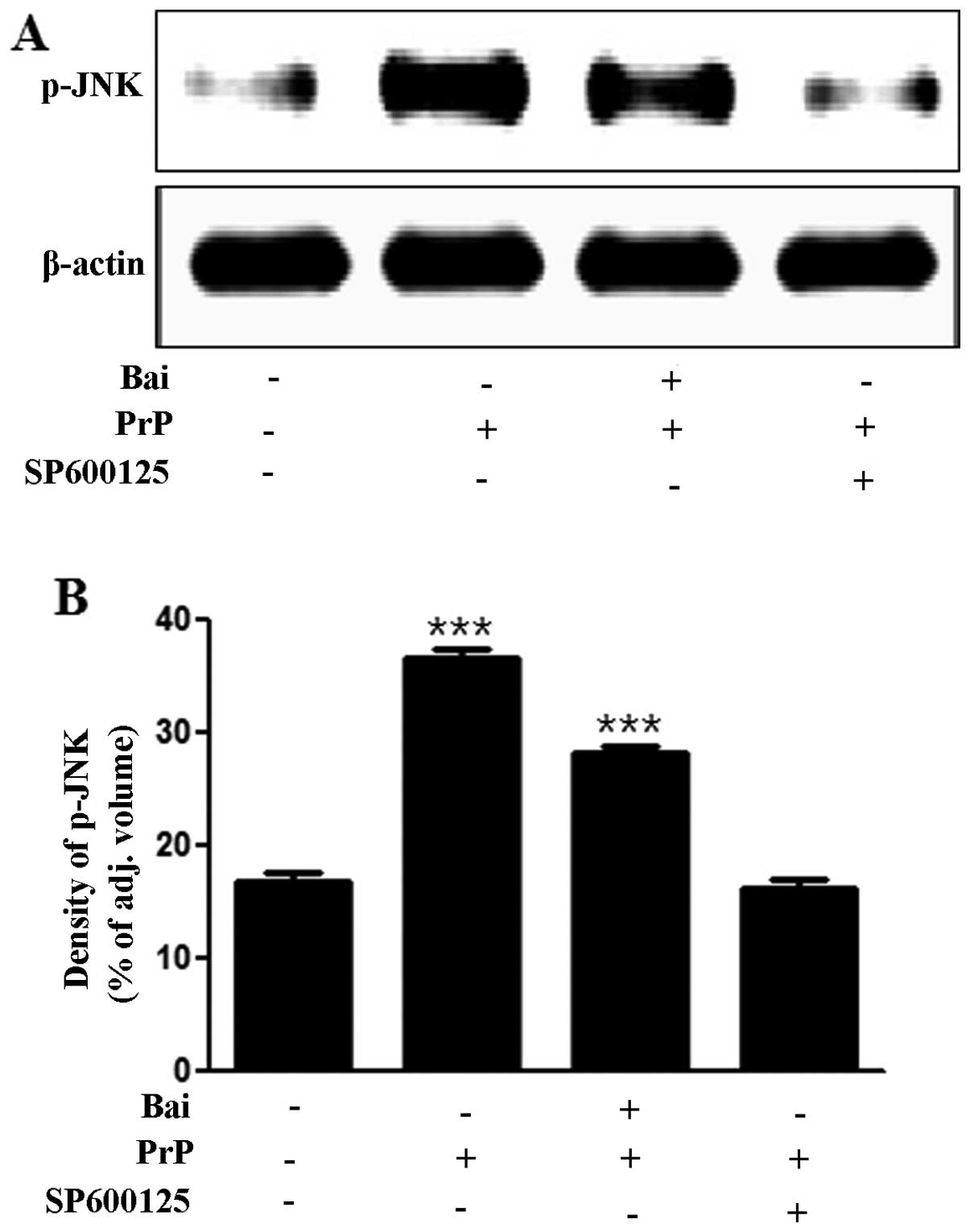|
1
|
Peretz D, Williamson RA, Kaneko K, et al:
Antibodies inhibit prion propagation and clear cell cultures of
prion infectivity. Nature. 412:739–743. 2001. View Article : Google Scholar : PubMed/NCBI
|
|
2
|
Aguzzi A: Prion diseases of humans and
farm animals: epidemiology, genetics, and pathogenesis. J
Neurochem. 97:1726–1739. 2006. View Article : Google Scholar : PubMed/NCBI
|
|
3
|
Caughey B, Raymond GJ, Ernst D and Race
RE: N-terminal truncation of the scrapie-associated form of PrP by
lysosomal protease(s): implications regarding the site of
conversion of PrP to the protease-resistant state. J Virol.
65:6597–6603. 1991.PubMed/NCBI
|
|
4
|
Selvaggini C, De Gioia L, Cantu L, et al:
Molecular characteristics of a protease-resistant, amyloidogenic
and neurotoxic peptide homologous to residues 106–126 of the prion
protein. Biochem Biophys Res Commun. 194:1380–1386. 1993.
View Article : Google Scholar : PubMed/NCBI
|
|
5
|
Forloni G, Angeretti N, Chiesa R, et al:
Neurotoxicity of a prion protein fragment. Nature. 362:543–546.
1993. View
Article : Google Scholar : PubMed/NCBI
|
|
6
|
Florio T, Grimaldi M, Scorziello A, et al:
Intracellular calcium rise through L-type calcium channels, as
molecular mechanism for prion protein fragment 106–126-induced
astroglial proliferation. Biochem Biophys Res Commun. 228:397–405.
1996. View Article : Google Scholar : PubMed/NCBI
|
|
7
|
De Gioia L, Selvaggini C, Ghibaudi E, et
al: Conformational polymorphism of the amyloidogenic and neurotoxic
peptide homologous to residues 106–126 of the prion protein. J Biol
Chem. 269:7859–7862. 1994.PubMed/NCBI
|
|
8
|
Corsaro A, Thellung S, Villa V, et al:
Prion protein fragment 106–126 induces a p38 MAP kinase-dependent
apoptosis in SH-SY5Y neuroblastoma cells independently from the
amyloid fibril formation. Ann N Y Acad Sci. 1010:610–622. 2003.
View Article : Google Scholar
|
|
9
|
Halliwell B: Oxidative stress and
neurodegeneration: where are we now? J Neurochem. 97:1634–1658.
2006. View Article : Google Scholar : PubMed/NCBI
|
|
10
|
Jabs T: Reactive oxygen intermediates as
mediators of programmed cell death in plants and animals. Biochem
Pharmacol. 57:231–245. 1999. View Article : Google Scholar : PubMed/NCBI
|
|
11
|
Scherz-Shouval R, Shvets E, Fass E, Shorer
H, Gil L and Elazar Z: Reactive oxygen species are essential for
autophagy and specifically regulate the activity of Atg4. EMBO J.
26:1749–1760. 2007. View Article : Google Scholar : PubMed/NCBI
|
|
12
|
Borger E, Aitken L, Muirhead KE, et al:
Mitochondrial β-amyloid in Alzheimer’s disease. Biochem Soc Trans.
39:868–873. 2011. View Article : Google Scholar : PubMed/NCBI
|
|
13
|
Coskun P, Wyrembak J, Schriner SE, et al:
A mitochondrial etiology of Alzheimer and Parkinson disease.
Biochim Biophys Acta. 1820:553–564. 2012. View Article : Google Scholar :
|
|
14
|
Siskova Z, Mahad DJ, Pudney C, et al:
Morphological and functional abnormalities in mitochondria
associated with synaptic degeneration in prion disease. Am J
Pathol. 177:1411–1421. 2010. View Article : Google Scholar : PubMed/NCBI
|
|
15
|
O’Donovan CN, Tobin D and Cotter TG: Prion
protein fragment PrP-(106–126) induces apoptosis via mitochondrial
disruption in human neuronal SH-SY5Y cells. J Biol Chem.
276:43516–43523. 2001. View Article : Google Scholar
|
|
16
|
Shang YZ, Gong MY, Zhou XX, Li ST and Wang
BY: Improving effects of SSF on memory deficits and pathological
changes of neural and immunological systems in senescent mice. Acta
Pharmacol Sin. 22:1078–1083. 2001.PubMed/NCBI
|
|
17
|
Shang Y, Cheng J, Qi J and Miao H:
Scutellaria flavonoid reduced memory dysfunction and neuronal
injury caused by permanent global ischemia in rats. Pharmacol
Biochem Behav. 82:67–73. 2005. View Article : Google Scholar : PubMed/NCBI
|
|
18
|
Bochorakova H, Paulova H, Slanina J, Musil
P and Taborska E: Main flavonoids in the root of Scutellaria
baicalensis cultivated in Europe and their comparative antiradical
properties. Phytother Res. 17:640–644. 2003. View Article : Google Scholar : PubMed/NCBI
|
|
19
|
Heo HJ, Kim DO, Choi SJ, Shin DH and Lee
CY: Potent inhibitory effect of flavonoids in Scutellaria
baicalensis on amyloid beta protein-induced neurotoxicity. J Agric
Food Chem. 52:4128–4132. 2004. View Article : Google Scholar : PubMed/NCBI
|
|
20
|
Huang Y, Wong CM, Lau CW, et al:
Inhibition of nitric oxide/cyclic GMP-mediated relaxation by
purified flavonoids, baicalin and baicalein, in rat aortic rings.
Biochem Pharmacol. 67:787–794. 2004. View Article : Google Scholar : PubMed/NCBI
|
|
21
|
Chen YC, Shen SC, Chen LG, Lee TJ and Yang
LL: Wogonin, baicalin, and baicalein inhibition of inducible nitric
oxide synthase and cyclooxygenase-2 gene expressions induced by
nitric oxide synthase inhibitors and lipopolysaccharide. Biochem
Pharmacol. 61:1417–1427. 2001. View Article : Google Scholar : PubMed/NCBI
|
|
22
|
Chang WS, Lee YJ, Lu FJ and Chiang HC:
Inhibitory effects of flavonoids on xanthine oxidase. Anticancer
Res. 13:2165–2170. 1993.PubMed/NCBI
|
|
23
|
Kyo R, Nakahata N, Sakakibara I, Kubo M
and Ohizumi Y: Baicalin and baicalein, constituents of an important
medicinal plant, inhibit intracellular Ca2+ elevation by
reducing phospholipase C activity in C6 rat glioma cells. J Pharm
Pharmacol. 50:1179–1182. 1998. View Article : Google Scholar : PubMed/NCBI
|
|
24
|
Liao JF, Hung WY and Chen CF:
Anxiolytic-like effects of baicalein and baicalin in the Vogel
conflict test in mice. Eur J Pharmacol. 464:141–146. 2003.
View Article : Google Scholar : PubMed/NCBI
|
|
25
|
Yu X, He G and Du G: Neuroprotective
effect of baicalein in patients with Parkinson’s disease. Zhongguo
Zhong Yao Za Zhi. 37:421–425. 2012.in Chinese. PubMed/NCBI
|
|
26
|
Mu X, He GR, Yuan X, Li XX and Du GH:
Baicalein protects the brain against neuron impairments induced by
MPTP in C57BL/6 mice. Pharmacol Biochem Behav. 98:286–291. 2011.
View Article : Google Scholar : PubMed/NCBI
|
|
27
|
Carimalo J, Cronier S, Petit G, et al:
Activation of the JNK-c-Jun pathway during the early phase of
neuronal apoptosis induced by PrP106–126 and prion infection. Eur J
Neurosci. 21:2311–2319. 2005. View Article : Google Scholar : PubMed/NCBI
|
|
28
|
Lee E, Park HR, Ji ST, Lee Y and Lee J:
Baicalein attenuates astroglial activation in the
1-methyl-4-phenyl-1,2,3,4-tetrahydro-pyridine-induced Parkinson’s
disease model by downregulating the activations of nuclear
factor-kappaB, ERK, and JNK. J Neurosci Res. 92:130–139. 2014.
View Article : Google Scholar
|
|
29
|
Lee JH and Lee SR: The effect of baicalein
on hippocampal neuronal damage and metalloproteinase activity
following transient global cerebral ischaemia. Phytother Res.
26:1614–1619. 2012. View
Article : Google Scholar : PubMed/NCBI
|
|
30
|
Liu C, Wu J, Xu K, et al: Neuroprotection
by baicalein in ischemic brain injury involves PTEN/AKT pathway. J
Neurochem. 112:1500–1512. 2010. View Article : Google Scholar : PubMed/NCBI
|
|
31
|
Kovacic P and Somanathan R: Redox
processes in neurode-generative disease involving reactive oxygen
species. Curr Neuropharmacol. 10:289–302. 2012. View Article : Google Scholar :
|
|
32
|
Chakraborty S, Bornhorst J, Nguyen TT and
Aschner M: Oxidative stress mechanisms underlying Parkinson’s
disease-associated neurodegeneration in C. elegans. Int J Mol Sci.
14:23103–23128. 2013. View Article : Google Scholar : PubMed/NCBI
|
|
33
|
Beal MF: Mitochondria take center stage in
aging and neurode-generation. Ann Neurol. 58:495–505. 2005.
View Article : Google Scholar : PubMed/NCBI
|
|
34
|
Radi R, Cassina A and Hodara R: Nitric
oxide and peroxynitrite interactions with mitochondria. Biol Chem.
383:401–409. 2002. View Article : Google Scholar : PubMed/NCBI
|
|
35
|
Bolanos JP, Moro MA, Lizasoain I and
Almeida A: Mitochondria and reactive oxygen and nitrogen species in
neurological disorders and stroke: therapeutic implications. Adv
Drug Deliv Rev. 61:1299–1315. 2009. View Article : Google Scholar : PubMed/NCBI
|
|
36
|
Choi JH, Choi AY, Yoon H, et al: Baicalein
protects HT22 murine hippocampal neuronal cells against endoplasmic
reticulum stress-induced apoptosis through inhibition of reactive
oxygen species production and CHOP induction. Exp Mol Med.
42:811–822. 2010. View Article : Google Scholar : PubMed/NCBI
|
|
37
|
Shen HM and Liu ZG: JNK signaling pathway
is a key modulator in cell death mediated by reactive oxygen and
nitrogen species. Free Radic Biol Med. 40:928–939. 2006. View Article : Google Scholar : PubMed/NCBI
|
|
38
|
Sato M, Bagchi D, Tosaki A and Das DK:
Grape seed proanthocyanidin reduces cardiomyocyte apoptosis by
inhibiting ischemia/reperfusion-induced activation of JNK-1 and
C-JUN. Free Radic Biol Med. 31:729–737. 2001. View Article : Google Scholar : PubMed/NCBI
|
|
39
|
Yoshizumi M, Kogame T, Suzaki Y, et al:
Ebselen attenuates oxidative stress-induced apoptosis via the
inhibition of the c-Jun N-terminal kinase and activator protein-1
signalling pathway in PC12 cells. Br J Pharmacol. 136:1023–1032.
2002. View Article : Google Scholar : PubMed/NCBI
|













